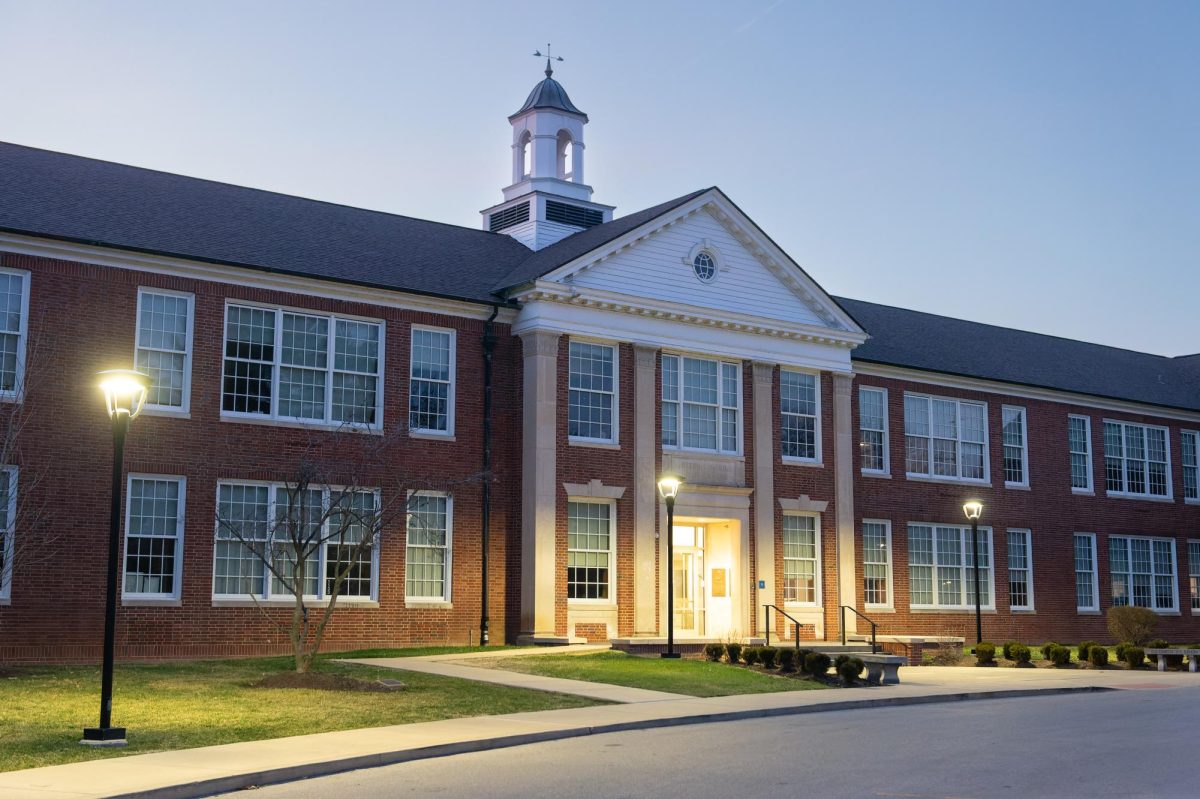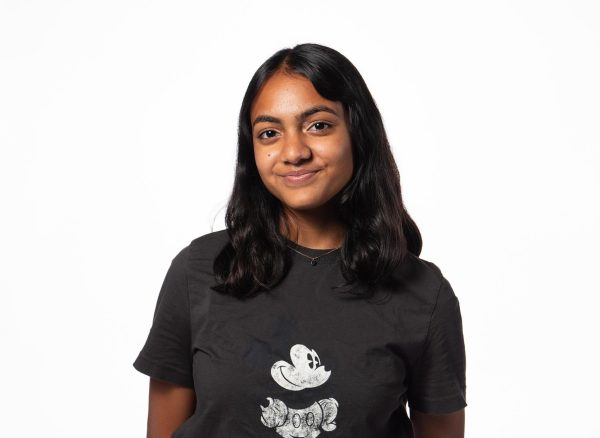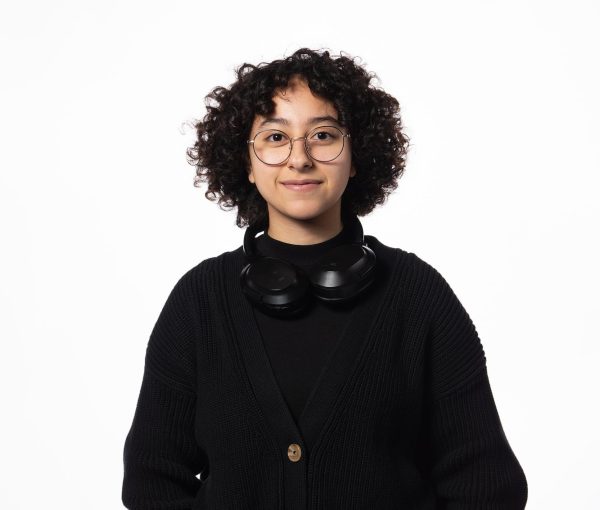**An abridged version of this story appeared in the April 2024 issue of Panorama. Below is the full piece.
Sleek solar panels adorn rooftops like shimmering scales, wind turbines spin gracefully atop hillsides and verdant parks intertwine with bustling cityscapes. Pedestrians stroll tree-lined streets, breathing air as crisp and clean as a mountain breeze, while wildlife frolics in revitalized habitats. Yet, when gazing upon our current reality, the stark disparity between this utopia and the harsh truth of the present climate crisis becomes painfully evident.
Climate change, a term first coined by Wallace Broecker in 1975, refers to environmental shifts largely affecting temperature and weather patterns. While the Earth’s climate has always varied, humans have accelerated these changes, culminating in an unprecedented climate crisis.
However, it would be an oversight to say that no one is improving the situation. Every day, governments, large corporations and individual citizens maintain and create environmentally-conscious standards. While some believe that even this amount of action will not be adequate, others continue to innovate, hoping to one day avert the climate catastrophe.
Background
Because of St. Louis’ Midwest location, some disregard climate change’s effects. Social studies teacher Kelley Krejnik disagrees with this claim. She obtained her Master’s Degree in sustainability and has since pioneered a new class, Sustainable Investigations, at Ladue High School. Thus, she’s well versed on the science and history surrounding climate change.
“It might seem [as though] St. Louis’ weather has always been pretty erratic,” Krejnik said. “That is true to a point, but if we look at the data, we’re going to see that the temperatures are actually starting to creep up.”
The newfound variation affects everything on the planet, from sea life to severe storms. One such area is agriculture, a sector often overlooked by the general public.
“Missouri is largely a rural state, so [farmers] are starting to be concerned about the crops they traditionally have grown, thinking about whether they will continue to thrive and produce the same meals as they have previously,” Krejnik said. “The weather patterns are changing and the temperatures are changing, and a couple of degrees can make a big difference between not enough time for freezing or not enough time for germination.”
Elliot Kellner, Director of Commercial Innovation at the Donald Danforth Plant Science Center, is similarly concerned with the implications of modern agricultural practices.
“At the Danforth Center, we’re working on making all of these important crops more drought tolerant [and] more pest resilient,” Kellner said. “In an environmental setting of changing climates, hopefully we can still be efficient and effective at producing food to make sure that people still have just as much food available as [they] do now. Specifically, we’re doing so in a way that is more environmentally conscious.”
Regardless of how Kellner and the agricultural industry hope to innovate science, many agree that environmental changes, no matter how small or large, will occur.
“Some of the things that we take for granted as being part of our life rituals are going to change,” Krejnik said. “The climate, the weather [and] the environment are such instrumental parts of our social fabric and our cultural fabric that we have to think about. What do we want to hold on to, what do we want to preserve, what do we want to start anew, what do we want to prevent and how do we want to be resilient?”
Environmental Discrimination
Ultimately, climate change will affect everyone on the planet. However, the means and intensity of this exposure differ widely throughout the world, and often fall upon socioeconomic and racial divides.
“Environmental risks tend to be avoidable if you have the financial means to avoid those risks or exposure to dangers,” Krejnik said. “If you lack means [and] political clout you’re going to inevitably increase your odds of being exposed to harmful toxins. You’re also more likely to end up in environments that are less comfortable and come under health effects. Fewer trees, less wildlife, [decreased] quality of water, high traffic areas, higher rates of smog or ozone [and] proximity to landfill sites decrease the property values where people live. Then, because of the overlay of racism and classism, that will put people at [a] greater risk of damage.”
The agricultural industry paints a stark picture when examining environmental racism. Since 1973, when genetic modifications came about, popular plants such as corn or soybean have been subject to improvements that align with the world’s changing temperatures. They’re specifically targeted because many western populations consume them on a daily basis. However, the cassava plant, a major staple in the developing world, lags behind in such genetic developments.
“There are [about] 365 million people in sub-Saharan Africa that are functionally dependent on cassava for their food security,” Kellner said. “But, until about 15 years ago, cassava had never been the target for any kind of genetic improvement because people in the United States don’t eat cassava and neither do people in Europe. There’s no market for it, and all of the firms that do that type of really high tech work are in the West.”
For-profit companies tend to focus on crops with high monetary value for economic reasons. The Danforth Center is uniquely situated in this regard, as they are a nonprofit and are able to spend money on crops such as cassava without fear of lack of profits. However, this is only one type of environmental classism — another form is present within the United States itself.
“In Mississippi, there are petrochemical plants that create a lot of toxins that have increased the rate of cancer,” Krejnik said. “People who live there have lived there for generations and they don’t necessarily want to leave. They [also] didn’t build the chemical plants, are suffering and don’t always have the financial means to relocate. We get into a lot of these interesting ethical debates about who’s responsible for what, how do we help people, how do we repair the harms that could be caused, how do we prevent those harms [and] who is responsible for all of this. They’re not easy answers.”
False Information
High schoolers are often asked such questions in their classes, leading climate change to become a popular topic on social media platforms. While there’s an opportunity for promoting education and awareness, this also leaves ample room for misinformation.
“[There is] a lot of backlash perpetuated against the renewable energies that we have now,” SAGE director Ella Marks (12) said. “They do have their flaws — it’s not perfectly clean energy. I think that [that] can be very damaging, especially when people think renewables are worse for the environment. [However], that’s not necessarily true unless you only look at one component of it.”
A popular example of misinformation is electric vehicles. According to the MIT Climate Portal, EV manufacturing produces 80% more emissions than the production of their gas-powered counterparts. However, this singular statistic paints an incomplete picture of EVs.
“I think it’s important to keep in mind that sustainability as it is now isn’t completely perfect,” Marks said. “Ideally, in the future, our practices can be environmentally friendly without any sort of harm to other areas of life. Right now though, it’s not always linen-wrapped and pretty.”
The trade-off of sustainability can be observed through lithium mining and Chile’s indigenous communities. According to the Natural Resources Defense Council, in 2022, Chile was the world’s second largest producer of lithium, a critical component of batteries. However, this focus also contributed to the country’s water crisis. Hence, in the attempt to achieve sustainability, environments and people may suffer. Most sources covering sustainability lack nuance and paint an idealistic picture of environmentalism that ignores the true reality. As SAGE leader Gabe Bernstein (12) notes, these attempts to sanitize and achieve the “look” of sustainability may have resulted in greenwashing. Bernstein has taken two environmental classes at Ladue High School as well as completed internships with the Shaw Nature Reserve and Washington University in St. Louis.
“[Greenwashing is] where products will try to [appear] sustainable to [cater to] that demographic of people who want to be sustainable,” Bernstein said. “When you really look into it, it’s not sustainable at all. It’s really harmful because people don’t always have the drive, motivation or time to do all this research to figure out if [a product] is sustainable.”
Greenwashing often includes claims or press statements that portray efforts to improve practices without actually taking any action. It can also involve cheating on pollution tests or using the color green in advertising and promotional products and campaigns.
“Every time you go on social media you’ll see some new [product or practice] that is just totally insane,” Marks said. “Right now, sustainability seems super expensive. It’s not [an individual] responsibility, especially with people in lower income communities.”
Amidst the attempts to move towards environmentally-friendly practices is the issue of attainability. Items like sea sponge tampons, toothpaste pellets and environmentally-conscious fashion are all products that have been promoted across social media platforms. However, a lot of these guidelines can be expensive, harmful or difficult to implement. Additionally, the amount of advice given, much of it contradictory, can make the concept of even attempting to be sustainable an insurmountable task.
“I don’t think buying only what you need is essential or realistic,” Marks said. “You shouldn’t persecute someone because they buy stuff that they want sometimes.”
Seeking Solutions
With the sea of misinformation, trends, advice and research, it can seem like practically nothing we do can help the climate crisis.
“There needs to be more of a cohesive effort towards sustainable practices,” Bernstein said. “Obviously, it’s not very realistic if we just want to convert everything to electrical or solar power in the next few years. There are a lot of things that the government can be doing — it’s just that people don’t have enough force to drive the government to [action].”
While some believe that the government is responsible for climate change, others argue that it is up to individuals and that the government cannot mandate sustainable choices. Kellner believes that there are limitations to the impact that individual decisions have.
“Everybody should be out there doing everything that they can do to improve the situation,” Kellner said. “But, at the end of the day, there’s a real limit to what one individual can do. [For example], if you ceased all [of] your own greenhouse gas emissions personally or in your household, does it change something? Yes, but it’s not observable.”
Having worked alongside federal agencies in the public sector, Kellner has been able to observe the limitations of government. Now that he works with for-profit agricultural-technology companies, he has found another way to adopt environmentally beneficial practices.
“We see very limited adoption of technologies that come out of the public sector,” Kellner said. “However, technologies that are actually taken to market by for-profit companies are seeing much higher rates of adoption. Normally, that’s because there’s some sort of positive financial benefit for the farmer.”
Beyond agricultural technology, the entire food industry has begun to adopt more sustainable practices. For example, Burger King’s Impossible Whopper utilizes artificially synthesized heme, a blood molecule, to replicate the taste of traditional burgers. Innovative technologies such as these can pressure large corporations to change. However, many students lack the opportunity to invent new technologies. Nonetheless, they have found alternative ways to contribute.
“The most impact clubs like SAGE have is on local ecosystems [and] local communities,” Marks said. “Tree planting movements may not stop climate change, [and] I understand that. But, in terms of a local level, those restoration efforts can be really great for raising awareness. I feel that showing that young people like high schoolers are interested in this can really have a big impact.”
While it won’t contribute to massive decreases in emissions, halt deforestation or restore ice caps in the same way extensive scientific research and government intervention can, there may be value in developing a genuine care for nature and the local environment.
“Anyone can [ask themself], ‘When do I stop and wonder [about] whatever nature is actually around?’” Krejnik said. “Instead of seeing [the environment] as a disappointment, see awe in what is going on on that day. [Take] the bees that were in the tree [April 1 at Ladue High School]. That might seem like a nuisance to some people, but it’s incredible when you stop and think. Those are bees, and the world needs those pollinators. There could be a day and a place where that type of thing is so rare and so unheard of that you’ll be telling that story to somebody. I don’t want that to be the case.”
Small changes, from plants blooming earlier to changes in animal migration patterns, show climate change’s real ramifications. St. Louis residents, specifically, have dealt with increased flooding as a result of changing temperatures. Citizens tend to take notice when effects are observable from their backyard, school or wallet.
“Never underestimate what an uncomfortable human will do to become comfortable,” Kellner said. “There are technical solutions to the climate crisis. Some of those solutions are expensive, but through innovation we can make them cheaper. Or, through public action, we can fund them or subsidize them. So, we’re going to make it. It’s going to be weird, but we’re going to get there.”








